Yizhi Wang
MAGREF: Masked Guidance for Any-Reference Video Generation
May 29, 2025Abstract:Video generation has made substantial strides with the emergence of deep generative models, especially diffusion-based approaches. However, video generation based on multiple reference subjects still faces significant challenges in maintaining multi-subject consistency and ensuring high generation quality. In this paper, we propose MAGREF, a unified framework for any-reference video generation that introduces masked guidance to enable coherent multi-subject video synthesis conditioned on diverse reference images and a textual prompt. Specifically, we propose (1) a region-aware dynamic masking mechanism that enables a single model to flexibly handle various subject inference, including humans, objects, and backgrounds, without architectural changes, and (2) a pixel-wise channel concatenation mechanism that operates on the channel dimension to better preserve appearance features. Our model delivers state-of-the-art video generation quality, generalizing from single-subject training to complex multi-subject scenarios with coherent synthesis and precise control over individual subjects, outperforming existing open-source and commercial baselines. To facilitate evaluation, we also introduce a comprehensive multi-subject video benchmark. Extensive experiments demonstrate the effectiveness of our approach, paving the way for scalable, controllable, and high-fidelity multi-subject video synthesis. Code and model can be found at: https://github.com/MAGREF-Video/MAGREF
Subspecialty-Specific Foundation Model for Intelligent Gastrointestinal Pathology
May 28, 2025Abstract:Gastrointestinal (GI) diseases represent a clinically significant burden, necessitating precise diagnostic approaches to optimize patient outcomes. Conventional histopathological diagnosis, heavily reliant on the subjective interpretation of pathologists, suffers from limited reproducibility and diagnostic variability. To overcome these limitations and address the lack of pathology-specific foundation models for GI diseases, we develop Digepath, a specialized foundation model for GI pathology. Our framework introduces a dual-phase iterative optimization strategy combining pretraining with fine-screening, specifically designed to address the detection of sparsely distributed lesion areas in whole-slide images. Digepath is pretrained on more than 353 million image patches from over 200,000 hematoxylin and eosin-stained slides of GI diseases. It attains state-of-the-art performance on 33 out of 34 tasks related to GI pathology, including pathological diagnosis, molecular prediction, gene mutation prediction, and prognosis evaluation, particularly in diagnostically ambiguous cases and resolution-agnostic tissue classification.We further translate the intelligent screening module for early GI cancer and achieve near-perfect 99.6% sensitivity across 9 independent medical institutions nationwide. The outstanding performance of Digepath highlights its potential to bridge critical gaps in histopathological practice. This work not only advances AI-driven precision pathology for GI diseases but also establishes a transferable paradigm for other pathology subspecialties.
ACT-R: Adaptive Camera Trajectories for 3D Reconstruction from Single Image
May 13, 2025Abstract:We introduce adaptive view planning to multi-view synthesis, aiming to improve both occlusion revelation and 3D consistency for single-view 3D reconstruction. Instead of generating an unordered set of views independently or simultaneously, we generate a sequence of views, leveraging temporal consistency to enhance 3D coherence. Most importantly, our view sequence is not determined by a pre-determined camera setup. Instead, we compute an adaptive camera trajectory (ACT), specifically, an orbit of camera views, which maximizes the visibility of occluded regions of the 3D object to be reconstructed. Once the best orbit is found, we feed it to a video diffusion model to generate novel views around the orbit, which in turn, are passed to a multi-view 3D reconstruction model to obtain the final reconstruction. Our multi-view synthesis pipeline is quite efficient since it involves no run-time training/optimization, only forward inferences by applying the pre-trained models for occlusion analysis and multi-view synthesis. Our method predicts camera trajectories that reveal occlusions effectively and produce consistent novel views, significantly improving 3D reconstruction over SOTA on the unseen GSO dataset, both quantitatively and qualitatively.
PathOrchestra: A Comprehensive Foundation Model for Computational Pathology with Over 100 Diverse Clinical-Grade Tasks
Mar 31, 2025Abstract:The complexity and variability inherent in high-resolution pathological images present significant challenges in computational pathology. While pathology foundation models leveraging AI have catalyzed transformative advancements, their development demands large-scale datasets, considerable storage capacity, and substantial computational resources. Furthermore, ensuring their clinical applicability and generalizability requires rigorous validation across a broad spectrum of clinical tasks. Here, we present PathOrchestra, a versatile pathology foundation model trained via self-supervised learning on a dataset comprising 300K pathological slides from 20 tissue and organ types across multiple centers. The model was rigorously evaluated on 112 clinical tasks using a combination of 61 private and 51 public datasets. These tasks encompass digital slide preprocessing, pan-cancer classification, lesion identification, multi-cancer subtype classification, biomarker assessment, gene expression prediction, and the generation of structured reports. PathOrchestra demonstrated exceptional performance across 27,755 WSIs and 9,415,729 ROIs, achieving over 0.950 accuracy in 47 tasks, including pan-cancer classification across various organs, lymphoma subtype diagnosis, and bladder cancer screening. Notably, it is the first model to generate structured reports for high-incidence colorectal cancer and diagnostically complex lymphoma-areas that are infrequently addressed by foundational models but hold immense clinical potential. Overall, PathOrchestra exemplifies the feasibility and efficacy of a large-scale, self-supervised pathology foundation model, validated across a broad range of clinical-grade tasks. Its high accuracy and reduced reliance on extensive data annotation underline its potential for clinical integration, offering a pathway toward more efficient and high-quality medical services.
CINEMA: Coherent Multi-Subject Video Generation via MLLM-Based Guidance
Mar 13, 2025Abstract:Video generation has witnessed remarkable progress with the advent of deep generative models, particularly diffusion models. While existing methods excel in generating high-quality videos from text prompts or single images, personalized multi-subject video generation remains a largely unexplored challenge. This task involves synthesizing videos that incorporate multiple distinct subjects, each defined by separate reference images, while ensuring temporal and spatial consistency. Current approaches primarily rely on mapping subject images to keywords in text prompts, which introduces ambiguity and limits their ability to model subject relationships effectively. In this paper, we propose CINEMA, a novel framework for coherent multi-subject video generation by leveraging Multimodal Large Language Model (MLLM). Our approach eliminates the need for explicit correspondences between subject images and text entities, mitigating ambiguity and reducing annotation effort. By leveraging MLLM to interpret subject relationships, our method facilitates scalability, enabling the use of large and diverse datasets for training. Furthermore, our framework can be conditioned on varying numbers of subjects, offering greater flexibility in personalized content creation. Through extensive evaluations, we demonstrate that our approach significantly improves subject consistency, and overall video coherence, paving the way for advanced applications in storytelling, interactive media, and personalized video generation.
Multimodal Distillation-Driven Ensemble Learning for Long-Tailed Histopathology Whole Slide Images Analysis
Mar 02, 2025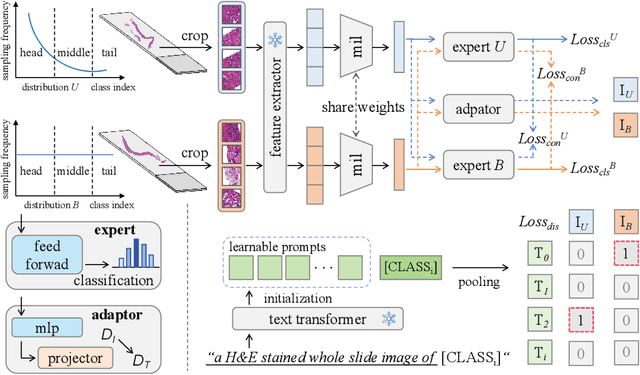



Abstract:Multiple Instance Learning (MIL) plays a significant role in computational pathology, enabling weakly supervised analysis of Whole Slide Image (WSI) datasets. The field of WSI analysis is confronted with a severe long-tailed distribution problem, which significantly impacts the performance of classifiers. Long-tailed distributions lead to class imbalance, where some classes have sparse samples while others are abundant, making it difficult for classifiers to accurately identify minority class samples. To address this issue, we propose an ensemble learning method based on MIL, which employs expert decoders with shared aggregators and consistency constraints to learn diverse distributions and reduce the impact of class imbalance on classifier performance. Moreover, we introduce a multimodal distillation framework that leverages text encoders pre-trained on pathology-text pairs to distill knowledge and guide the MIL aggregator in capturing stronger semantic features relevant to class information. To ensure flexibility, we use learnable prompts to guide the distillation process of the pre-trained text encoder, avoiding limitations imposed by specific prompts. Our method, MDE-MIL, integrates multiple expert branches focusing on specific data distributions to address long-tailed issues. Consistency control ensures generalization across classes. Multimodal distillation enhances feature extraction. Experiments on Camelyon+-LT and PANDA-LT datasets show it outperforms state-of-the-art methods.
Unlocking adaptive digital pathology through dynamic feature learning
Dec 29, 2024Abstract:Foundation models have revolutionized the paradigm of digital pathology, as they leverage general-purpose features to emulate real-world pathological practices, enabling the quantitative analysis of critical histological patterns and the dissection of cancer-specific signals. However, these static general features constrain the flexibility and pathological relevance in the ever-evolving needs of clinical applications, hindering the broad use of the current models. Here we introduce PathFiT, a dynamic feature learning method that can be effortlessly plugged into various pathology foundation models to unlock their adaptability. Meanwhile, PathFiT performs seamless implementation across diverse pathology applications regardless of downstream specificity. To validate PathFiT, we construct a digital pathology benchmark with over 20 terabytes of Internet and real-world data comprising 28 H\&E-stained tasks and 7 specialized imaging tasks including Masson's Trichrome staining and immunofluorescence images. By applying PathFiT to the representative pathology foundation models, we demonstrate state-of-the-art performance on 34 out of 35 tasks, with significant improvements on 23 tasks and outperforming by 10.20% on specialized imaging tasks. The superior performance and versatility of PathFiT open up new avenues in computational pathology.
Diagnostic Text-guided Representation Learning in Hierarchical Classification for Pathological Whole Slide Image
Nov 16, 2024



Abstract:With the development of digital imaging in medical microscopy, artificial intelligent-based analysis of pathological whole slide images (WSIs) provides a powerful tool for cancer diagnosis. Limited by the expensive cost of pixel-level annotation, current research primarily focuses on representation learning with slide-level labels, showing success in various downstream tasks. However, given the diversity of lesion types and the complex relationships between each other, these techniques still deserve further exploration in addressing advanced pathology tasks. To this end, we introduce the concept of hierarchical pathological image classification and propose a representation learning called PathTree. PathTree considers the multi-classification of diseases as a binary tree structure. Each category is represented as a professional pathological text description, which messages information with a tree-like encoder. The interactive text features are then used to guide the aggregation of hierarchical multiple representations. PathTree uses slide-text similarity to obtain probability scores and introduces two extra tree specific losses to further constrain the association between texts and slides. Through extensive experiments on three challenging hierarchical classification datasets: in-house cryosectioned lung tissue lesion identification, public prostate cancer grade assessment, and public breast cancer subtyping, our proposed PathTree is consistently competitive compared to the state-of-the-art methods and provides a new perspective on the deep learning-assisted solution for more complex WSI classification.
GALA: Geometry-Aware Local Adaptive Grids for Detailed 3D Generation
Oct 13, 2024



Abstract:We propose GALA, a novel representation of 3D shapes that (i) excels at capturing and reproducing complex geometry and surface details, (ii) is computationally efficient, and (iii) lends itself to 3D generative modelling with modern, diffusion-based schemes. The key idea of GALA is to exploit both the global sparsity of surfaces within a 3D volume and their local surface properties. Sparsity is promoted by covering only the 3D object boundaries, not empty space, with an ensemble of tree root voxels. Each voxel contains an octree to further limit storage and compute to regions that contain surfaces. Adaptivity is achieved by fitting one local and geometry-aware coordinate frame in each non-empty leaf node. Adjusting the orientation of the local grid, as well as the anisotropic scales of its axes, to the local surface shape greatly increases the amount of detail that can be stored in a given amount of memory, which in turn allows for quantization without loss of quality. With our optimized C++/CUDA implementation, GALA can be fitted to an object in less than 10 seconds. Moreover, the representation can efficiently be flattened and manipulated with transformer networks. We provide a cascaded generation pipeline capable of generating 3D shapes with great geometric detail.
Agent Aggregator with Mask Denoise Mechanism for Histopathology Whole Slide Image Analysis
Sep 18, 2024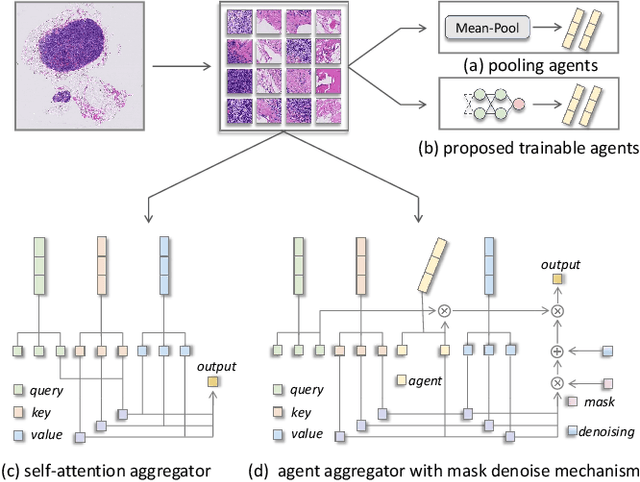
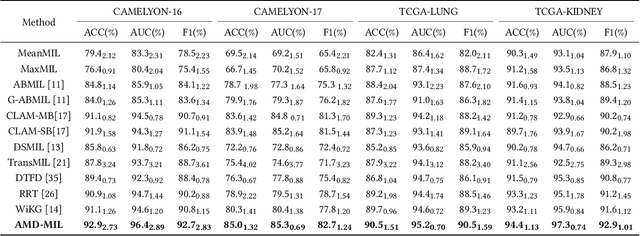
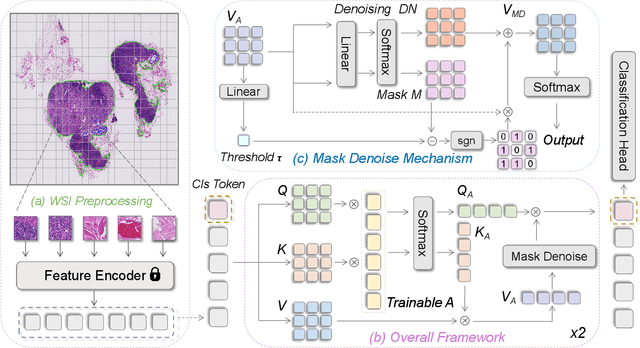
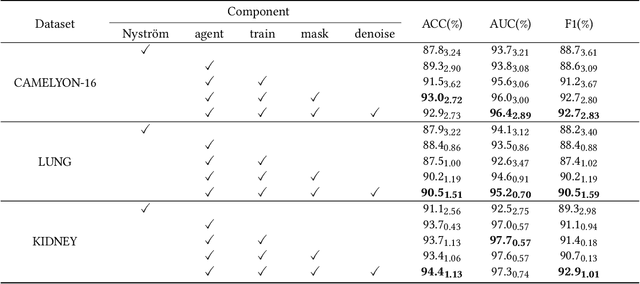
Abstract:Histopathology analysis is the gold standard for medical diagnosis. Accurate classification of whole slide images (WSIs) and region-of-interests (ROIs) localization can assist pathologists in diagnosis. The gigapixel resolution of WSI and the absence of fine-grained annotations make direct classification and analysis challenging. In weakly supervised learning, multiple instance learning (MIL) presents a promising approach for WSI classification. The prevailing strategy is to use attention mechanisms to measure instance importance for classification. However, attention mechanisms fail to capture inter-instance information, and self-attention causes quadratic computational complexity. To address these challenges, we propose AMD-MIL, an agent aggregator with a mask denoise mechanism. The agent token acts as an intermediate variable between the query and key for computing instance importance. Mask and denoising matrices, mapped from agents-aggregated value, dynamically mask low-contribution representations and eliminate noise. AMD-MIL achieves better attention allocation by adjusting feature representations, capturing micro-metastases in cancer, and improving interpretability. Extensive experiments on CAMELYON-16, CAMELYON-17, TCGA-KIDNEY, and TCGA-LUNG show AMD-MIL's superiority over state-of-the-art methods.
 Add to Chrome
Add to Chrome Add to Firefox
Add to Firefox Add to Edge
Add to Edge